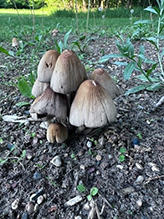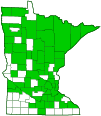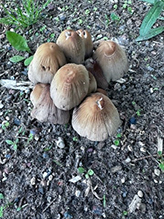Common Ink Cap
(Coprinopsis atramentaria)
Conservation • Description • Habitat • Ecology • Distribution • Taxonomy
|
|
||||||||||||||
Description |
Common Ink Cap is a common, edible but potentially poisonous gilled mushroom. It occurs in Europe, Asia, and North America, and it has been found in Australia and South Africa. It is widely distributed in the United States, but it is mostly absent from the deep south, the Great Plains, and the Great Basin. It is common in Minnesota. Common Ink Cap is found in spring, summer, and fall, in woodlands and gardens, on lawns and roadsides, and around old tree stumps. It appears on the ground in clusters, in dense groups, or sometimes scattered. It obtains its nutrients from already decaying wood (saprobic). It is often attached to buried wood, making it appear to be terrestrial. When it first appears, the cap is oval and grayish brown to grayish tan, often browner in the center and pale on the margins. The surface has silky fibers (fibrils) attached, remnants of the universal veil. As it ages, the cap spreads out, becoming cone shaped or bell shaped. Mature caps are lead gray, grayish, or grayish brown, convex, 1¼″ to 2⅜″ (3 to 6 cm) high, and up to 4″ (10 cm) in diameter. The surface is smooth. The margins are faintly lined or grooved, and they are usually split or tattered. The gills are white when young, crowded, and not attached or barely attached to the stalk (free or almost free). They turn gray as the spores mature. Eventually they become black and liquefy (deliquesce), turning to ink. The stalk is white, hollow, fibrous, 3″ to 6″ (8 to 15 cm) long, and ¼″ to ½″ (6 to 12 mm) thick. It may be narrowed or enlarged at the base, or equal in thickness from top to bottom. There may be grayish to brownish fibrils near the bottom. The flesh is thin, soft, and pale to grayish. It is edible, but it contains the metabolite coprine. If any amount of alcohol is consumed up to three days before or after eating the mushroom, it will cause “disulfiram syndrome.” The symptoms include facial reddening, nausea, vomiting, malaise, agitation, palpitations, and tingling in limbs. There is no treatment beyond rehydrating after vomiting and reassurance that the symptoms are not fatal. The spore print is black. |
Similar Species |
Habitat and Hosts |
Woodlands, gardens, lawns, roadsides, and around old tree stumps |
Ecology |
Season |
Spring, summer, and fall |
Distribution |
||
|
Sources |
|
| 6/4/2024 | ||
Occurrence |
||
Common |
||
Taxonomy |
|
Kingdom |
Fungi (Fungi) |
Subkingdom |
Dikarya |
Phylum |
Basidiomycota (Basidiomycete Fungi) |
Subphylum |
Agaricomycotina (Higher Basidiomycetes) |
Class |
Agaricomycetes (Mushrooms, Bracket Fungi, Puffballs, and Allies) |
Subclass |
Agaricomycetidae |
Order |
|
Suborder |
Agaricineae |
Family |
Psathyrellaceae (brittlestems and allies) |
Genus |
Coprinopsis (inkcaps) |
Section |
Atramentariae |
|
|
Common Ink Cap was previously classified as Coprinus atramentarius in the family Agaricaceae. A molecular DNA study published in 2001 showed that most of the species in the genus Coprinus were only distantly related to the type species Coprinus comatus. All but three species were moved to the new family Psathyrellaceae and assigned new genera. |
|
Subordinate Taxa |
|
|
|
Synonyms |
|
Agaricus atramentarius Agaricus luridus Agaricus plicatus Agaricus sobolifer Coprinus atramentarius Coprinus atramentarius var. sobolifer Coprinus luridus Coprinus plicatus Coprinus sobolifer Hypophyllum atramentarium Pselliophora atramentaria Pselliophora sobolifera |
|
Common Names |
|
Common Ink Cap Common Inkcap Inky Cap Smooth Inky Cap Tippler’s Bane |
|
Glossary
Saprobic
A term often used for saprotrophic fungi. Referring to fungi that obtain their nutrients from decayed organic matter.
Universal veil
An egg-like structure that envelopes all or most of a developing gill mushroom. Remnants of the universal veil sometimes visible on a mature mushroom are patchy warts on the cap, a ring on the stem, and a volva at the base of the stem.
Visitor Photos |
||
Share your photo of this fungus. |
||
This button not working for you? |
||
Paul |
||
 |
||
MinnesotaSeasons.com Photos |
||
|
||
|
||

Slideshows |
|

Visitor Videos |
||
Share your video of this fungus. |
||
This button not working for you? |
||
|
Other Videos |
||
Coprinopsis atramentaria (Coprinus atramentarius) Edible Not mixed with alcohol |
About
Apr 28, 2019 (Translated by Chrome) Coprinopsis atramentaria (Bull.) Redhead, Vilgalys & Moncalvo 2001 By: Manu Merino Habitat: in meadows and gardens Edible, but it should never be mixed with alcoholic beverages, in this case it is toxic. A shame that it cannot be shared with a good wine Hat up to 10 cm in diameter Foot up to 12 cm long, hollow Place: In some gardens in Santutxu - Bilbao |
Coprinopsis atramentaria, ink cap or inky cap, is an edible, sometimes poisonous mushroom |
About
Apr 6, 2019 I go through the forests, mountains, hills, fields, and waters to understand the living world and to create a living mind. Consuming Coprinopsis atramentaria within a few hours of alcohol results in a disulfiram syndrome. |
Common Ink Cap (Coprinopsis atramentaria and the Shaggy Ink Cap (Coprinus comatus) |
About
Oct 16, 2019 How to tell the difference between these two similar mushrooms. By www.wildfooduk.com |

|
Created: 6/4/2024 Last Updated: © MinnesotaSeasons.com. All rights reserved. |



